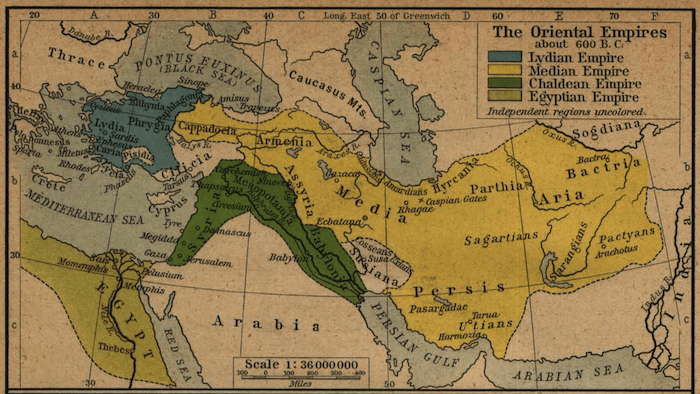Cultures > Assyria Collapse
Assyria Collapse
Background
In 612 BC commanding a united force of Babylonians, Chaldeans, Persians, Medes, Scythians, Cimmerians and many other tribes, Nabopolassar launched an invasion of the Assyrian capital city of Nineveh and all of the remaining cities of the Assyrian Empire. After a prolonged siege named the Battle of Nineveh the city was eventually sacked and razed to the ground, never to be rebuilt again. This effectively meant the end of the Assyrian Empire and directly led to the rise of the Neo-Babylonian Empire.

Assyrian Empire Territories Map
Somehow a general related to the royal family named Ashur-uballit II (612-608 BC) survived and managed to flee the carnage. He later claimed the throne of Assyria in the apparent wake of the death of king Sin-shar-ishkun in the midst of all this chaos. Fleeing the city he would later attempt to rally the remnants of his army along with an Egyptian mercenary force to take back Nineveh and Ashur from his base in an outer territory. However, they were ultimately unsuccessful and this led to the complete collapse of the Assyrian Empire.
This sacking saw the utter destruction of the great palace at Nineveh which actually managed to preserve the Library of Ashurbanipal underneath. In fact it is only because of this event that we have the massive amount of history regarding the Assyrians that we do. By burning and destroying the palace complex it actually greatly preserved the clay cuneiform tablets allowing us to understand a great deal about Assyrian history today. It also appears the city of Ashur was also sacked and razed to the ground during this period, eliminating any real trace of Assyrian culture from the capitals themselves.

Mesopotamian Empires (600 BC) - Historical Atlas (1923)
When the Babylonian coalition let the palace on fire it collapsed around the library which contained not paper, but clay cuneiform tablets. The collapse of the palace baked the tablets even harder and buried them where they were preserved for archaeologists to discover. The destruction of Assyria was so complete that after two generations no one even remembered where the cities were. Buried beneath the sands of the desert they lay, waiting to be discovered by researchers over two thousand years later. While the main cities of Assyria had been crushed, remnants of the city including a general related to the royal family named Ashur-uballit II along with some of the military managed to flee to the outer territory city of Harran.
Fall of Harran
See Fall of Harran
After sacking the city the combined Babylonian and Median forces along with their associated tribes pursued the fleeing Assyrians to the city. Following another victory in what became known as the Fall of Harran, the Assyrian forces were further forced to retreat to the even more peripheral territory known as Carchemish. Here the remnants of the Assyrian forces still under the command of Ashur-uballit II planned to meet up with Egyptian mercenary forces under the command of Necho II to take back the territory of Harran. Necho got caught up and had to face stomp the Kingdom of Judah along with its leader Josiah because he chose to try and block the path of the invading Egyptians at the Battle of Megiddo (609 BC).
Battle of Carchemish
After successfully meeting up with the Egyptian mercenaries, the newly bolstered Assyrian coalition launched a surprise invasion of Harran and hoped to take back the region from Nabopolassar and the occupying force. They were unsuccessful in this attempt and were once again routed back to the city of Carchemish. However, this time Nabopolassar was not playing around and he sent his son Nebuchadnezzar II to personally deal with the problem.
Nebuchadnezzar crushed the combined Assyrian and Egyptian forces, killing Ashur-uballit II and slaughtering the Assyrian army. Being the last of the Assyrian royal family, the bloodline was lost. The Egyptians and Necho II managed to flee the engagement because on their hasty return to Egypt they still found him to sack the son of Josiah and impose a tribute on the city state of gold and silver, probably to pay for the remaining mercenaries in their command.
Following the battle Nebuchadnezzar had to quickly return home back to Babylon as his father was dying and he needed to secure the throne. If not for these dire circumstances he may have pursued the Egyptians all the way to Egypt. Overall the outcome of this battle meant the end of the Assyrian Empire for good. While the average Assyrians were assimilated into the new Neo-Babylonia Empire, there would never again be an Assyrian dynasty in history.